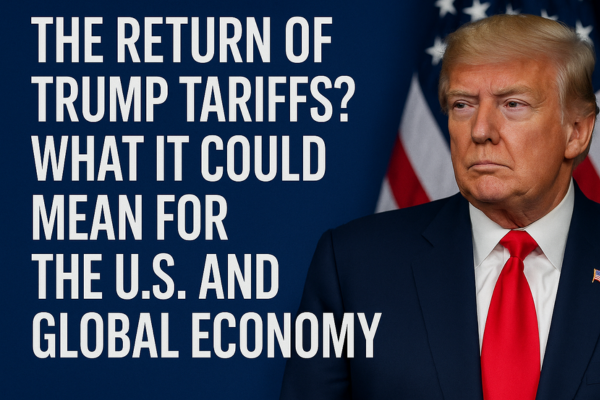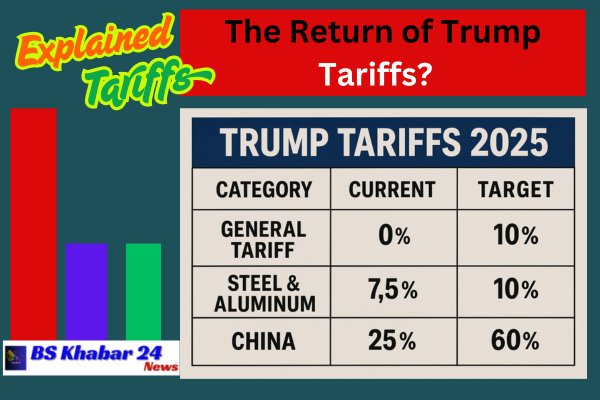The Return of Trump Tariffs? What It Could Mean for the U.S. and Global Economy

One name continues to dominate headlines as the 2024 U.S. presidential contest intensifies: Donald J. Trump. Additionally, his extravagant demeanour attracts attention, yet his proposed policies are once again having an impact on the global economy. Among the most important subjects discussed? tariffs.
Indeed, the Trump Tariffs, a term that shook world markets during his first term, are returning to the political and economic debate. What precisely are they, though, and why should regular Americans be concerned?
A Quick Refresher: What Were the Trump Tariffs?
Trump implemented a number of tariffs, which are basically taxes on imported goods, throughout his presidency from 2017 to 2021 in an effort to defend American industries, particularly steel and manufacturing. The reasoning was rather simple: firms and customers may choose American-made products if the price of imported items increases.
Tariffs were applied to a wide range of goods, but some of the biggest moves included:
- A 25% tariff on steel and 10% on aluminum
- Broad tariffs on Chinese goods worth hundreds of billions of dollars, aiming to counter what the Trump administration called unfair trade practices.
- Targeted tariffs on goods from allies like Canada, the EU, and Mexico, which caused diplomatic tensions.
Supporters called it a bold move to rebalance global trade. Critics saw it as a gamble that led to higher prices for consumers and strain on international relationships.
The 2025 Vision: Tariffs 2.0?
Now, Trump is once again floating the idea of sweeping tariffs—this time with an even broader brush. Reports and public comments suggest he’s considering:
- A 10% universal tariff on all
- A much steeper 60% tariff on Chinese goods.
According to Trump and his economic advisors, this would “bring jobs back home” and reduce reliance on countries like China, which he accuses of manipulating trade and threatening U.S. manufacturing.
But experts are divided—just like they were five years ago.

The Potential Impact on American Wallets
Let’s discuss money matters. How would you and I be affected by this?
Tariffs affect more than just foreign businesses; they frequently result in higher costs for consumers. American businesses typically pass on higher costs if they must purchase foreign items, resources, or parts. Consider everything from groceries to vehicles to smartphones: if some of it is imported, the cost may increase.
Indeed, research conducted during Trump’s first term indicated that tariff-related expenditures raised American households’ annual income by thousands. Farmers were disproportionately affected since U.S. agricultural exports were the subject of retaliatory tariffs from other nations (such as China), which forced the federal government to provide billions of dollars in help.
Supporters of Trump, of course, contend that the long-term benefits outweigh the short-term suffering. They claim it’s about national security, economic independence, and making sure American workers have equal opportunities.
A Global Domino Effect?
Trump Tariffs are not imposed arbitrarily. Other nations frequently retaliate in kind when the United States boosts tariffs, creating what economists refer to as a “trade war.” This tit-for-tat behaviour hurt exporters on both sides and created uncertainty in international markets during Trump’s presidency.
Many worry that a fresh trade war, particularly with China, might destabilise already precarious global supply chains if these new tariff ideas are implemented. Do you recall the shortages brought on by the pandemic? Economists are concerned that high tariffs would cause comparable disruptions again.
Politics Meets Economics
The political atmosphere and tariff discussions are inextricably linked. A portion of the populace that feels left behind by globalisation finds appeal in Trump’s tariff plans. Manufacturing communities that have experienced factory closures and job outsourcing are frequently open to the “America First” rhetoric.
However, a number of academics, business executives, and even Republican politicians caution that if such tariffs hit middle-class Americans by driving up costs, they might have unintended economic and political consequences.
So… What Happens Next?
Trump Tariffs are once again a topic of national discussion, regardless of whether Trump wins in November. Even President Biden has imposed new trade restrictions of his own and maintained some of the tariffs imposed by Trump, particularly on high-tech goods linked to national security.
Trump’s plan, however, is much more extreme and, if carried out, might usher in a new era of protectionism. The reinstatement of the Trump tariffs would be a significant shift in the way that the United States conducts international trade, for better or worse.
